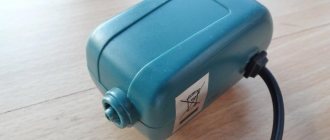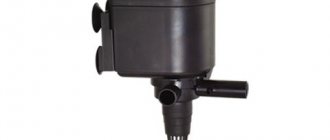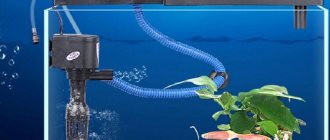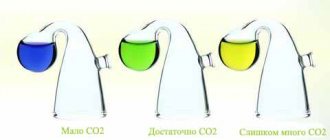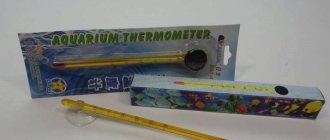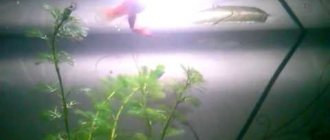Why do you need a compressor in an aquarium?
The need for such a device in a glass aquarium is due to the fact that it is a closed space. As a result, there is a lack of oxygen, which has a bad effect on fish and plants. Due to their waste products, dust, film on the surface and small debris, the water can become like a swamp. An aquarium compressor is designed to save you from such a situation. It performs the function of aeration - natural saturation of water with oxygen.
Why is it needed?
Inexperienced owners are confident that the amount of oxygen released by plants is sufficient for a comfortable life for the inhabitants. Algae produce O2, but in small quantities, which is not enough for large-volume containers.
The formation of the aquatic ecosystem is negatively affected by:
- fish excrement;
- rotten particles of food at the bottom;
- lack of oxygen has a bad effect on the formation of the aquatic ecosystem.
Exotic fish species are picky about their living conditions, so the lack of sufficient air can lead to illness or even death. Also, standing water is subject to the formation of a film on its surface. The air flows supplied by the compressor enrich the tank with oxygen, which is necessary for the healthy development of the inhabitants. This process is called aeration (supplying air into the aquarium). All water layers are mixed together, so the reservoir does not look like a swamp.
How does an aquarium compressor work?
The operating principle of an aquarium compressor is very simple. Air enters the water through the tubes, the pressure of which is regulated using clamps and valves. Completely different parts of the compressor are responsible for bubbles. These are atomizers attached to air tubes.
They create small bubbles, which are also a decorative decoration, especially in combination with lighting, as can be seen in the photo. The sprayers are located at the very bottom. Each rising bubble mixes the water, equalizing its temperature. In addition, the bacterial and dust film on the surface is destroyed.
Principle of operation
The principle of operation of the compressor
A special tube is placed in the vessel, at the end of which there is a sprayer. Through it, the compressor supplies air which enters the atomizer. It is the sprayer that saturates the water with small bubbles. In addition to aeration, mixing of water takes place, as well as water in a vessel at the same temperature.
Sometimes the aerator is used for decorative purposes. Water bubbles look beautiful, complemented by colored lighting. Such a multi-colored aquarium will look gorgeous.
The aerator may not work all day. It is enough to turn it on at night, when there is no light and the algae do not produce oxygen by absorbing carbon dioxide.
In summer, it is advisable to turn on the aerator more often, so as to simultaneously enrich the water with oxygen and mix it.
During the spawning period, it is recommended to turn on the device. There is no time limit on how long the device should work. Only the aquarist, observing the aquatic world, should regulate its operating time.
Adjustable
According to one classification, a compressor for fish can be unregulated or adjustable. In the latter case, the front or side panel of the device housing has a special regulator. By rotating it, you can influence the performance of the compressor, thereby changing the number of bubbles. This increases or decreases the intensity of aeration. An adjustable air compressor can have different types of regulation:
- Electronic. It limits the movement of membranes. The disadvantage is that the electronic part is subject to heating.
- Mechanical. The vibrations of the membranes are limited by the claws or the magnets are moved away from the coil inside the aquarium compressor itself.
- Blocking the output channel. More common option. In this case, the valve located at the transition from the air duct to the sprayer is closed.
Types of regulation
The aquarium compressor is divided into two types according to the adjustment method:
- Adjustable.
- Unregulated.
In adjustable models, the structure of the device includes a regulator, by rotating which the owner can change the power and the supply of oxygen bubbles to the tank. In turn, adjustable models are divided into the following types:
- A device with an electronic type of regulation works by limiting the stroke of the membranes, but has a drawback: when turned on for a long time, the device gets very hot.
- The essence of the mechanical type of work is that the oscillations of the membranes are limited by magnets or claws.
- Shutting off the valve - if you close the outlet valve located on the hose, you can control the supply of oxygen to the artificial reservoir.
In addition to adjustable ones, there are devices with no regulation - devices that are not equipped with additional elements to control the air supply. In other words, it is impossible to change the flow intensity, as well as the noise emitted by the device. In addition, such models consume a lot of electricity, so some aquarists build silent aquarium compressors with their own hands, using a cooler and special taps.
Unregulated
An unregulated compressor is simpler in design. It has no additional parts that would affect the power of the device and aeration. Performance remains constant, so energy consumption increases. In addition, the noise from such an aquarium compressor cannot be reduced by reducing its power. In this case, some craftsmen independently install special taps on the air duct tubes, and replace the aerator itself with a regular cooler from a computer.
Why turn it off?
Turning off the compressor at night can have various reasons - the owner wants to save energy or does not consider it necessary to operate it at night, believing that the fish are sleeping.
However, you must understand that any pets come with various expenses, so even before purchasing animals, you need to think about whether you are ready for additional expenses for living creatures. Fish need their own aquarium, additional lighting and aeration, food and plants that make their daytime existence easier.
Types of compressors for aquariums
One of the main classifications divides aquarium compressors into three main groups - membrane, piston and pumps. Their differences lie in price, operating principle and noise level. A membrane compressor for fish is also called a vibration compressor. It pumps air by contracting an elastic rubber membrane due to the transmission of vibrations from a magnet inside the device. Pistons operate thanks to an electric motor that drives the piston. The pump is a universal device for aerating and filtering water. It is suitable for large aquariums.
Piston
The operating principle of this type of compressor is based on the movement of a piston that pushes out air. Rotational movements of the shaft are converted into oscillatory ones. This leads to achieving the required air supply power. If your fish live in a bedroom or recreation room, then a piston compressor for an aquarium would be ideal. It doesn't make as much noise, but it's not as cheap as a membrane one. You can use both types of compressors at once. Turn on the piston at night, and the membrane during the day. The latter consumes less energy.
The main advantages of a piston compressor:
- durable;
- almost silent;
- high performance;
- Suitable for large aquariums.
Main disadvantages:
- consumes a lot of electricity;
- expensive.
Flaws
The main disadvantage of compressors is noise. Many tank owners install their aquarium pump in soundproof boxes. This partially helps solve the problem. Some manufacturers make models that are installed directly into the container. During the daytime, their work is almost inaudible.
When installing the aeration device, you must be careful, since the bulk is powered by electricity. Failure to comply with safety measures can lead to a short circuit, which will lead to the death of the inhabitants of the tank.
Alternative
The noise during operation of the aerator causes inconvenience. There is an alternative replacement - an oxidizer. This is a homemade filter aerator for an aquarium. With its help, oxygen is supplied to the reservoir through a chemical reaction. It is based on the decomposition of hydrogen peroxide into oxygen. A catalyst is required for continuous operation. Its role is played by metals. As a result of the reaction, the catalyst is oxidized and releases oxygen into the water. The device is used without electricity. Does not make noise during operation.
Aeration in the aquarium. I answer your questions
Adjustable and non-adjustable
Compressors may differ from each other by the presence of a special regulator. He is responsible for controlling the performance of the device and regulating the supply of bubbles in the aquarium. The compressor is equipped with a special device, thanks to which adjustment is made. There are several types of regulation:
- The mechanical type of regulation is based on the action of paws or magnets. And with their help, membrane vibrations are regulated.
- The electronic type limits the movement of the membranes. Among the disadvantages is the high degree of heating of the element.
- One common type is valve overlap. It is located on the tube, between the air duct and the atomizer. To regulate the air supply to the tank, it is necessary to shut off the element.
An unregulated compressor is not equipped with additional elements that regulate it. The design of the device is simple, and the performance remains unchanged. The disadvantage is the constant noise, which cannot be adjusted by reducing the power of the water pump. Consumes a lot of electricity.
- piston;
- membrane compressor.
The first type is more durable. The principle of its operation is based on the reciprocating movement of the piston, which pushes out air. The compressor makes little noise, which is an advantage of this model. It is well suited for aquariums located in bedrooms or children's rooms. The model can be installed in tanks with a large volume, as it has good power. It is repaired if necessary. Among the disadvantages of a piston compressor are high energy consumption and inflated price.
Diaphragm compressor
is simpler in design. The principle of its operation differs from the first type. This device passes air flow from a chamber that is connected to a membrane. Thanks to the oscillations of the magnet, a pressure difference is achieved, which leads to the process of supplying oxygen to the tank. It is characterized by low cost. Disadvantages include high noise levels and low power. It makes no sense to install it in aquariums with a volume of more than two hundred liters.
There are two types of aerators available. Diaphragm pump for aquarium
It is recommended to install during daylight hours. It is possible to connect it to several small aquariums at once. The second type is installed at night.
There are aerators that are powered by alkaline batteries. They are low-power and make a lot of noise when operating. The action time is about 5 hours. Used when moving or lacking access to electricity.
Required performance depending on the volume of the aquarium
Compressor performance plays an important role in selection. It may depend on the population of the reservoir, as well as its volume. Performance refers to the amount of air that the aerator moves over a certain period of time. It is calculated based on a value of 0.5–0.8 l/hour per liter of liquid in the tank.
For small aquariums with a volume of up to one hundred liters, an aerator with a capacity of up to 80 l/hour is suitable. Larger tanks will require a device with a capacity of up to 240 l/h.
When choosing an aerator, the height of the aquarium is taken into account. The larger it is, the more powerful it should be
be a device, since the incoming air overcomes the water pressure. They influence the power of the hole in the atomizer. If they are small, the aerator will need more power to supply oxygen.
Membrane
Otherwise, a membrane compressor for an aquarium works. It forces air to move from a chamber connected to the membrane. It shows pressure differences. They are created due to vibrations of a magnet, which are also transmitted to an elastic rubber membrane. Its advantage is low energy consumption. In addition, such a device can be repaired, although this will not have to be done often. It is also a relatively cheap device and can serve more than one aquarium. The disadvantage is low power and high noise levels.
Battery operated aquarium compressor
Aerators for aquariums of any type can be powered either from a 220 volt network or from batteries. The latter option is preferable only for moving long distances or in conditions where electricity often goes out. A battery-powered aquarium compressor is characterized by its high cost, low power and high noise level. They “eat” a lot of energy and work for no more than 4-6 hours. Then you have to buy a new set of batteries. For this reason, you should not choose such a microcompressor if you always have access to power.
Exploitation
This device belongs to the category of bought and for a long time. But in order for the device to serve for a long time, it is necessary to properly monitor it:
- Cooling. Only a correctly installed device will not overheat. If the temperature is higher than the permitted norm, it should be taken to a workshop or repaired yourself;
- Read the operating instructions for the aerator. It is recommended to disconnect the device from the power supply at night. This is to ensure that the device has the opportunity to “rest”. And this has a positive effect on its service life.
- There are models that it is not recommended to turn off often, but rather leave them on and they always work. The moment of rest for such aerators is the time when cleaning and changing the water in the vessel is performed. If the device is turned off, you need to keep an eye on the aquatic inhabitants.
- Regardless of the model, the devices should be cleaned. Because it will begin to poorly saturate the water with oxygen.
And in conclusion, is a compressor needed in an aquarium? Yes, it is. But the choice of a compressor for an aquarium, what model, and what parameters to pay attention to when purchasing are determined based on the volume of the vessel, the number of inhabitants and the presence of algae, and on the financial capabilities of the aquarist. But the main thing is to remember the saying “he who is stingy pays double!”
How to install a compressor in an aquarium
It is also important to install the device correctly. First you need to decide where it will be located - above the surface of the water or in a special tank outside the aquarium. Installing a compressor in an aquarium, especially a submersible one, is also carried out taking into account the need to clean the device - it is important that there are no problems with temporary dismantling. To eliminate noise from the device, you can place it on foam rubber, or, in extreme cases, foam plastic. The air ducts and sprayer are located at the bottom. You can simply press the tube with a shell or pebble.
Risk factors
It is very important to avoid overcrowding, and this depends on how large your aquarium
. If you turn off the air compressor at night in an aquarium teeming with fish, then in the morning there is a high probability of finding several individuals dead from lack of oxygen. This is explained by the fact that there is less oxygen per individual in an aquarium with a non-working compressor, and if it is overcrowded, then the chances of oxygen starvation increase several times.
During the day, the algae in the aquarium produce oxygen during photosynthesis, but at night the situation changes dramatically - at this time of day, plants, on the contrary, begin to consume oxygen from the water. Therefore, it is logical to assume that even in a not particularly densely populated aquarium, the night life of the fish is complicated.
Compressor performance
The main parameter that indicates the amount of air distilled by the device over a period of time. Optimal performance depends on the density of fish in the aquarium and their species. The traditional value is 0.5-0.8 l/hour per liter of “can” volume. By making simple calculations, you can determine that an aquarium with a volume of 100 liters will require a capacity of 50-80 l/hour, and for a 300 liter aquarium – 150-240 l/hour. The presence of a biofilter in the “bank” increases this value.
Compressor with regulator Barbus SB-348 A
Price:
- 450-500 rubles.
Characteristics:
- productivity –2 x 240 l/hour;
- number of channels – 2 x 4 l/min;
- power – 5 W;
- power adjustment – 2 levels.
Main advantages:
- made from high quality materials;
- equipped with air flow speed regulator.
Minuses:
- noisiness
Aquael Oxyboost 300 Plus
Price:
- 750-800 rubles.
Characteristics:
- productivity – 300 l/hour;
- number of channels – 2;
- power – 2.5 W;
- weight – 500 g;
- Power adjustment – yes.
Main advantages:
- the legs are made of soft rubber that absorbs vibration;
- stylish design;
- compact size.
Minuses:
- No
We take into account the details
The following factors must be taken into account:
- dimensions and shape of your aquarium;
- population of fish and snails;
- presence of algae in the aquarium;
- decorating elements.
The numerical characteristics of the water surface depend on the dimensions of your aquarium. The larger the space, the better the exchange of gases between living organisms and the external environment. In this case, the fish have excellent conditions for life, and the compressor also additionally regulates the oxygen supply.
Thus, it is always recommended to have, if not a huge, then a much larger aquarium
than is required for the number of free-swimming fish. The larger the tank's capacity, the less likely it is that your pets will experience oxygen deprivation at night if you plan to turn off the oxygen supply compressor. Try to avoid crowding in the aquarium by any means - remove growing plants, purchase a larger aquarium.
And if there is an overpopulation of fish, then remove them from the existing composition, leaving only the normalized number of individuals.
Based on everything described above, we can conclude that additional aeration can only be turned off in a spacious aquarium with a small population of algae and living creatures.
The next morning you can always determine for sure whether you made a mistake by turning off the compressor. If it is obvious that the fish have a lack of oxygen, do not allow the aeration to be turned off.
Remember about plants that consume oxygen at night - if there are a lot of them, they will “take” oxygen from the fish at night, complicating their breathing process.
If you take into account all the above factors and do not miss important points that lead to the death of fish, then the additional air supply can be turned off at night. In other cases, the compressor must
work
constantly .
You will learn whether it is possible to turn off the compressor in an aquarium at night from the following video.
Power
This characteristic determines the performance and the maximum amount of energy consumed. In addition, the immersion depth of the device depends on the power. The deeper you plan to place it, the higher this characteristic should be. Widespread models are with power from 2 to 11 W. The following compressor models are considered the best in this category.
Schego Optimal
Price:
- 1500-2100 rubles.
Characteristics:
- productivity – 250 l/hour;
- power – 5 W;
- weight – 600 g;
- cord – 1 m;
- Air flow adjustment – yes.
Main advantages:
- air filters can be replaced;
- almost silent;
- The design is designed to work in a suspended state.
Minuses:
- No.
Eheim air pump 400
Price:
- 2500-3100 rubles.
Characteristics:
- productivity – 400 (2 x 200) l/hour;
- number of channels – 2;
- power – 4 W;
- weight – 846 g;
- hose – 2 m;
- Air flow adjustment – each channel has it.
Main advantages:
- channels can work separately or as one using a tee;
- has rubber feet that dampen vibration;
- possibility of hanging.
Minuses:
- sprayers can only be fixed with a suction cup on glass walls;
- the hose is short.
Dimensions
The compressor is selected according to the size of the aquarium itself. If it is large, then there will not be any particular problem in this matter. What to do if the aquarium is very small? It is necessary to select compact aquariums. In most cases, they do not have very high performance and power. In addition, almost all compact models do not have the ability to regulate the air flow, but for small aquariums this is not particularly necessary.
Aquael OxyBoost 100 Plus
Price:
- 650 rubles.
Characteristics:
- productivity – 100 l/hour;
- number of channels – 1;
- power – 2.2 W;
- Dimensions (L x W x H) cm - 9.5 x 9.5 x 5.
Main advantages:
- compact size;
- fashionable design;
- round shape;
- consumes little electricity.
Minuses:
- no airflow adjustment.
Compressor DoPhin AP 1301
Price:
- 500 rubles.
Characteristics:
- productivity – 50 l/hour;
- number of channels – 1;
- power – 1.8 W;
- weight – 285 g;
- dimensions (L x W x H) cm – 10.2 x 6.0 x 7.0.
Main advantages:
- compact size;
- low power consumption.
Minuses:
- The kit does not include a check valve, hose or sprayer;
- fragility.
Manufacturer
Judging by customer reviews, the German brand Schego is in great demand with high power, which can also be adjusted. An alternative could be Eheim - silent compressors. Aerators from the Italian company Ferplast are inexpensive and not very noisy. Among the well-known brands are JBL, Hagen Marina, AquaEL, DoPhin, Tetra, Barbus, Jebo, Hailea. They have established themselves as manufacturers of quality products, examples of which are presented below.
Tetra APS 50
Price:
- 850 rubles.
Characteristics:
- productivity – 50 l/hour;
- number of channels – 1;
- power – 2.0 W.
Main advantages:
- compact size;
- innovative design with compacted housing walls;
- rubber mounts that reduce vibration;
- air flow control valve;
- consumes little electricity.
Minuses:
- No.
Hailea Aquarium air 9904
Price:
- 500 rubles.
Characteristics:
- productivity – 330 l/hour;
- number of channels – 2;
- power – 3.5 W;
- weight – 620 g;
- dimensions – 14.8 x 9.8 x 5.8 (cm)
Main advantages:
- compact size;
- beautiful body, small dimensions;
- silent operation;
- high performance, but consumes little electricity.
Minuses:
- No.
The best compressor for an aquarium
The rating of aquarium compressors includes those models that are in high demand for their characteristics and optimal price-quality ratio. You can study the description of these products, the features of their operation, the pros and cons, and the prices indicated for Moscow. The following compressor models were included in the rating:
Prime PR-H-6900
Manufacturer:
- China.
Features:
- Installed above the aquarium, otherwise requires a check valve.
Characteristics:
- productivity – 2x120 l/hour;
- number of channels – 2;
- power – 2.5 W;
- weight – 375 g.
Main advantages:
- compact size;
- beautiful body, small dimensions;
- quiet work.
Minuses:
- No.
Price:
- 630 rubles.
SCHEGO IDEAL
Manufacturer:
- Germany.
Features:
- very stable in continuous use.
Characteristics:
- productivity – 250 l/hour;
- number of channels – 2;
- power – 5 W;
- weight – 560 g.
Main advantages:
- compact size;
- high reliability;
- quiet work.
Minuses:
- No.
Price:
- 1200 rubles.
aPUMP
Manufacturer:
- AquaLighter (Ukraine).
Features:
- very stable in continuous use.
Characteristics:
- productivity – 100 l/hour;
- number of channels – 1;
- power – 1.5 W;
- weight – 236 g.
Main advantages:
- miniature;
- can be attached to a suction cup;
- Includes silicone hose and sprayer;
- very quiet operation.
Minuses:
- No.
Price:
- 1200 rubles.
SCHEGO WS 2
Manufacturer:
- Germany.
Features:
- can pump air to a depth of up to 2 m.
Characteristics:
- productivity – 250 l/hour;
- number of channels – 2;
- power – 5 W;
- weight – 600 g.
Main advantages:
- almost complete absence of noise during operation;
- possibility of hanging;
- regulator to control the intensity of aeration.
Minuses:
- No.
Price:
- 1600 rubles.
Barbus, 2 channels, 250 l/h, 12 W
Manufacturer:
- China.
Features:
- The battery lasts up to 12 hours, which can then be recharged.
Characteristics:
- productivity – 240 l/hour;
- number of channels – 2;
- power – 12 W;
- weight – 2250 g.
Main advantages:
- almost complete absence of noise during operation;
- works from mains or battery;
- high wear resistance;
- regulator for air flow control – 3 levels.
Minuses:
- heavy and voluminous;
- consumes a lot of electricity.
Price:
- 3200 rubles.


